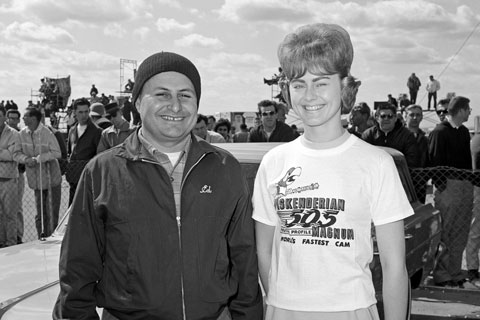SEMA News—December 2013
HERITAGE
Contemporary Cab-Over
By Drew Hardin
Photo Courtesy Petersen Archives
 Even if you’ve never seen the actual Deora show vehicle, chances are good that if you’re of a certain age, you built one as a plastic model kit or had a die-cast version in your Hot Wheels collection when you were young. But the Deora was a real, fullsize, running vehicle—one that captured the prestigious Ridler Award at the 1967 Detroit Autorama.
Even if you’ve never seen the actual Deora show vehicle, chances are good that if you’re of a certain age, you built one as a plastic model kit or had a die-cast version in your Hot Wheels collection when you were young. But the Deora was a real, fullsize, running vehicle—one that captured the prestigious Ridler Award at the 1967 Detroit Autorama.
The architects of the Deora—seen here during its construction—were Mike and Larry Alexander. The Detroit-based Alexander Brothers (also known as the A Brothers) started customizing cars in their father’s one-car garage in the mid-’50s. Their work was soon in such demand that they had to move from dad’s small garage to a bigger one and then to a dedicated workspace. Though they may not have gotten as much magazine exposure as other customizers due to their Michigan location, their handiwork is found on many of the era’s most famous hot rods and custom cars, including the Silver Sapphire, better known as the Little Deuce Coupe on the jacket of the Beach Boys record.
The Deora’s genesis began in 1964 when the brothers decided they wanted to customize one of the cab-over pickups popular then, such as Ford’s Econoline, Chevy’s Rampside and Dodge’s A100. They had been collaborating with Harry Bradley at that time. He was a member of GM’s design staff who was penning customs for the brothers in his off hours. Bradley sketched a radical-looking vehicle with a severely chopped roof—the better to integrate the truck’s upper and lower halves, he said—and no doors. Access to the truncated cab would be through a front-opening hatch.
 Chrysler execs loved the rendering and gave the Alexanders an A100 to customize. It was an incredibly complex job, and not just because of the engineering that had to be done to accommodate the single front door. In this photo (right), taken by Petersen photographer Pat Brollier in October 1965, the hatch is of one piece, following Bradley’s original design. But the cab’s A-pillars couldn’t support the weight of the hatch, so the Alexanders eventually fabricated a two-piece door with a flip-up window and a center-hinged lower panel.
Chrysler execs loved the rendering and gave the Alexanders an A100 to customize. It was an incredibly complex job, and not just because of the engineering that had to be done to accommodate the single front door. In this photo (right), taken by Petersen photographer Pat Brollier in October 1965, the hatch is of one piece, following Bradley’s original design. But the cab’s A-pillars couldn’t support the weight of the hatch, so the Alexanders eventually fabricated a two-piece door with a flip-up window and a center-hinged lower panel.
When it was finally completed, Chrysler loved the Deora so much that it leased the truck to go on the show circuit for a year and then renewed the lease for a second year—though it was repainted in lime green pearl for its second go-around.
So how did the Deora become a Mattel toy? Harry Bradley left GM to work at Mattel on the new die-cast car line in 1966. The Deora became one of the original 16 Hot Wheels cars released in 1968.






